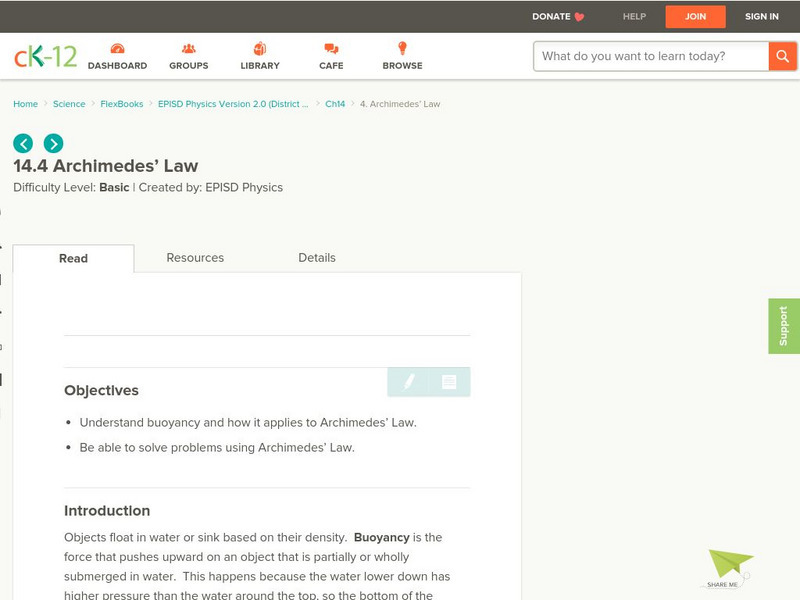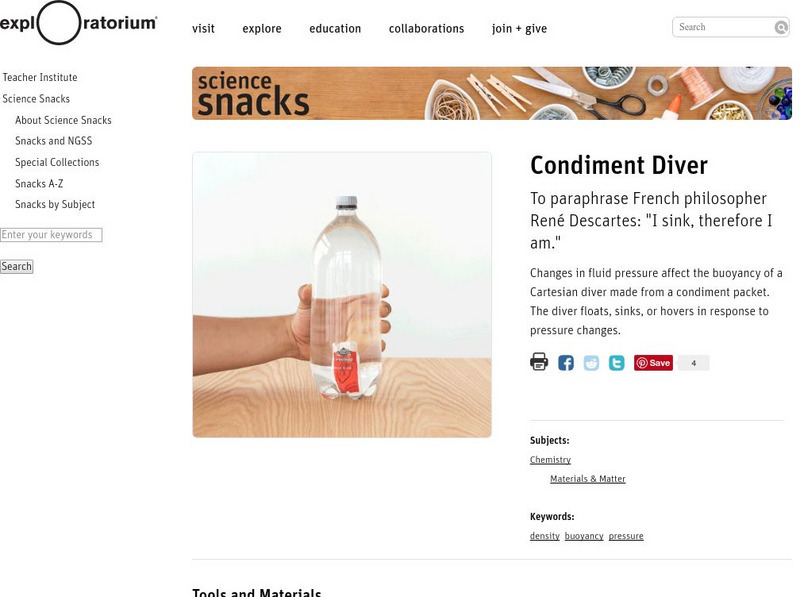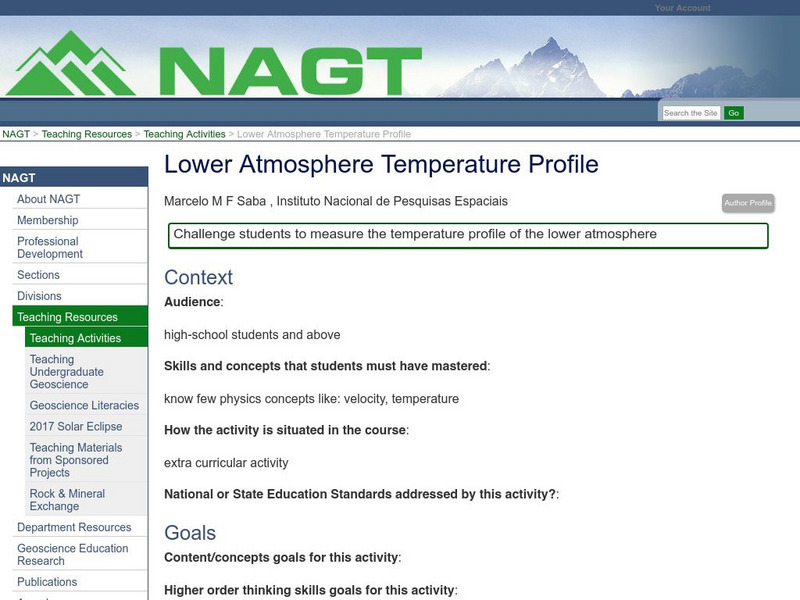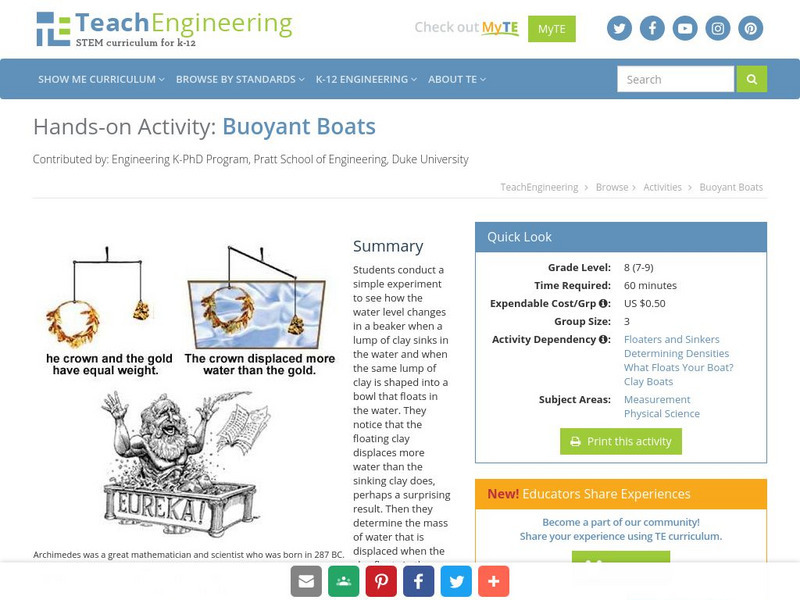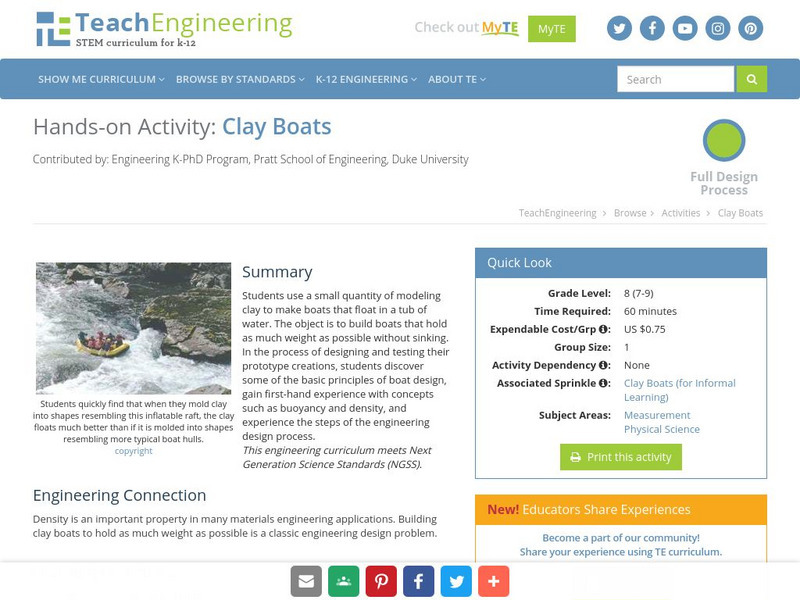Hi, what do you want to do?
Michigan Reach Out
Austin University: Demonstrating Air Pressure With Eggs
This site will tell you how you can use an egg to identify air pressure and how it affects objects. Includes easy step by step instructions.
My Science Site
Beneath the Sea: Blowing Ballast [Pdf]
Students dive down deep as they experience a hands-on activity and build a model of a submersible. Lesson plan includes a web connection, a teaching guide, extensions to learning as well as curriculum links and national science...
PBS
Pbs Kids: Sci Girls: Aquabot
Join Jake on an underwater rescue mission by building an underwater robot to help him find his ring. Players will learn about buoyancy while trying to rescue the treasure.
Other
Sprk: Sphero Hydro Hypothesis Stem Challenge [Pdf]
SPRK STEM challenges are fun, interactive activities that challenge students to use creativity and team-work to move through simple steps of the design process in order to build Sphero-based creations. The Hydro-hypothesis challenge...
Concord Consortium
The Concord Consortium: Molecular Workbench: Archimedes' Buoyancy Principle
Adjust the ratio of the masses of different particles to see how buoyancy is affected.
PBS
Pbs Teachers: Scientific American: Beneath the Sea: Blowing Ballast
Explore the use of ballast to manipulate buoyancy in submarines by building a model of a submersible using two-liter bottles and balloons. Describe the balance of forces that is responsible for the surfacing and diving of submersibles.
CK-12 Foundation
Ck 12: Archimedes' Law
[Free Registration/Login may be required to access all resource tools.] The use of Archimedes' Law to solve buoyancy problems is explained. Includes links to simulations on Archimedes' Principle and buoyancy.
Exploratorium
Exploratorium: Science Snacks: Eyedropper Hydrometer
Deepen the students' understanding of density by constructing a simple hydrometer that can be used to compare the densities of different solutions.
Exploratorium
Exploratorium: Science Snacks: Bubble Suspension
Explore the principles of buoyancy and semipermeability in this activity by using bubbles and dry ice.
Exploratorium
Exploratorium: Science Snacks: Condiment Diver
Use a condiment packet as a Cartesian diver to show how pressure changes cause the "diver" to float, sink or hover.
National Association of Geoscience Teachers
Serc: Lower Atmosphere Temperature Profile
Young scholars are challenged to measure the temperature profile of the lower atmosphere. Experiment serves as an introduction to buoyancy, drag force, sensor calibration, and data plotting.
Museum of Science
Museum of Science and Industry: Online Science: Design a Submarine
Become an engineer, and design a submarine that moves in the water like a real submarine. Try making it sink, float, and hover in the water.
TeachEngineering
Teach Engineering: Floating and Falling Flows
Students discover fluid dynamics related to buoyancy through experimentation and optional photography. Using one set of fluids, they make light fluids rise through denser fluids. Using another set, they make dense fluids sink through a...
TeachEngineering
Teach Engineering: Buoyant Boats
Students learn about displacement, density and buoyancy then apply their knowledge to build a floating object.
TeachEngineering
Teach Engineering: Clay Boats
Each student uses a small quantity of modeling clay to make a boat that will float in a tub of water. The object is to build a boat that will hold as much weight as possible without sinking. In the process of designing and testing their...
Mocomi & Anibrain Digital Technologies
Mocomi: Buoyancy
Ever wonder why/how things float? This concept is called buoyancy. Take this interactive journey to learn and understand how and why certain materials float and others sink to the ocean floor.
Read Works
Read Works: Take the Plunge
[Free Registration/Login Required] An informational text about the positive effects of swimming. A question sheet is available to help students build skills in reading comprehension.
CK-12 Foundation
Ck 12: Physical Science: Buoyancy
[Free Registration/Login may be required to access all resource tools.] Definition of buoyant force and how weight and density relate to buoyant force and the ability to float.
Other
Aquaholic: Buoyancy and Archimedes Principle
Description of buoyancy and a definition of Archimedes' Principle. Problems are presented and solved using Archimedes' Principle.
Physics Aviary
Physics Aviary: Practice Problems: Cargo Challenge Problem
Students figure out how much mass can be put in a boat without having the boat go fully under the fluid.
Physics Aviary
Physics Aviary: Practice Problems: Force Buoyancy Problem
Students must figure out the number of people that can go on a raft without having the raft go fully under the fluid.
Physics Aviary
Physics Aviary: Practice Problems: Percent Floating Challenge
Students must figure out how much of a ball will be under a fluid when it is in equilibrium with its environment.
University of California
University of California: Seawater Density & Salinity [Pdf]
Describes the properties of seawater and the variations depending on its location, e.g., near a shoreline, in an estuary, or as sea ice. Discusses the instruments scientists use to measure the density of water and explains other...
Science Struck
Science Struck: How to Find Volume With Water Displacement Method
Tells the story of how Archimedes discovered the Archimedes Principle and his water displacement method for determining the volume and density of an object. Provides an explanation and several examples of how it is done.






![Beneath the Sea: Blowing Ballast [Pdf] Lesson Plan Beneath the Sea: Blowing Ballast [Pdf] Lesson Plan](https://static.lp.lexp.cloud/images/attachment_defaults/resource/large/FPO-knovation.png)



